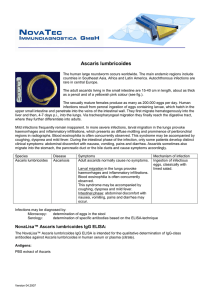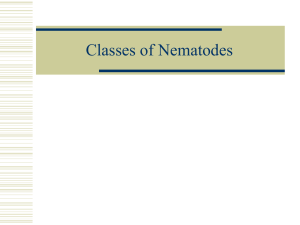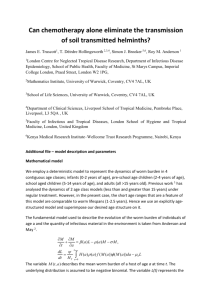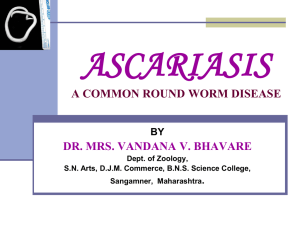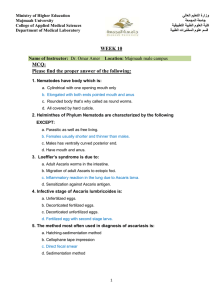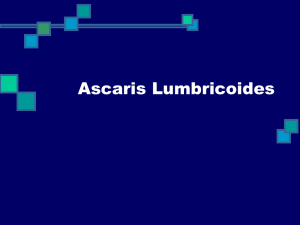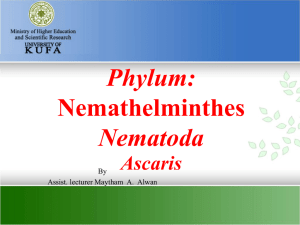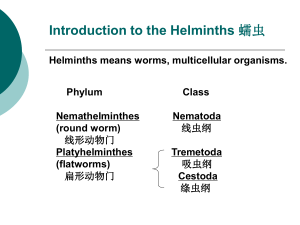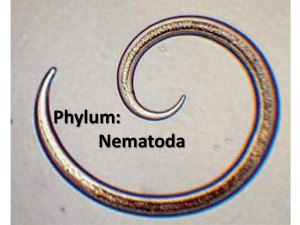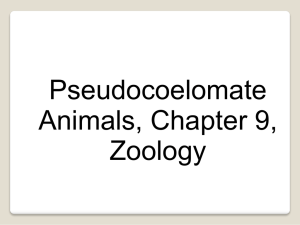Table S1. Summary of chemo-expulsion studies to have collected
advertisement
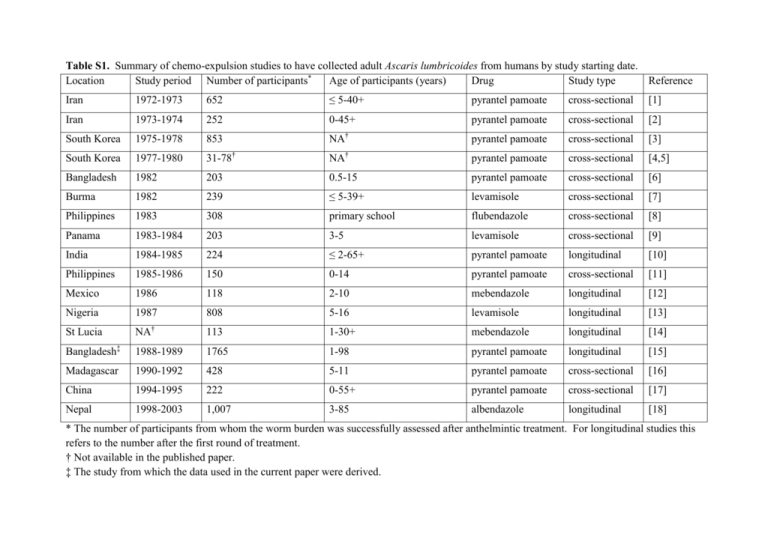
Table S1. Summary of chemo-expulsion studies to have collected adult Ascaris lumbricoides from humans by study starting date. Location Study period Number of participants* Age of participants (years) Drug Study type Reference Iran 1972-1973 652 ≤ 5-40+ pyrantel pamoate cross-sectional [1] Iran 1973-1974 252 0-45+ pyrantel pamoate cross-sectional [2] South Korea 1975-1978 853 NA† pyrantel pamoate cross-sectional [3] South Korea 1977-1980 31-78† NA† pyrantel pamoate cross-sectional [4,5] Bangladesh 1982 203 0.5-15 pyrantel pamoate cross-sectional [6] Burma 1982 239 ≤ 5-39+ levamisole cross-sectional [7] Philippines 1983 308 primary school flubendazole cross-sectional [8] Panama 1983-1984 203 3-5 levamisole cross-sectional [9] India 1984-1985 224 ≤ 2-65+ pyrantel pamoate longitudinal [10] Philippines 1985-1986 150 0-14 pyrantel pamoate cross-sectional [11] Mexico 1986 118 2-10 mebendazole longitudinal [12] Nigeria 1987 808 5-16 levamisole longitudinal [13] St Lucia NA† 113 1-30+ mebendazole longitudinal [14] Bangladesh‡ 1988-1989 1765 1-98 pyrantel pamoate longitudinal [15] Madagascar 1990-1992 428 5-11 pyrantel pamoate cross-sectional [16] China 1994-1995 222 0-55+ pyrantel pamoate cross-sectional [17] Nepal 1998-2003 1,007 3-85 albendazole longitudinal [18] * The number of participants from whom the worm burden was successfully assessed after anthelmintic treatment. For longitudinal studies this refers to the number after the first round of treatment. † Not available in the published paper. ‡ The study from which the data used in the current paper were derived. Table S1 References 1. Arfaa F, Ghadirian E (1977) Epidemiology and mass-treatment of ascariasis in six rural communities in central Iran. American Journal of Tropical Medicine and Hygiene 26: 866-871. 2. Croll NA, Anderson RM, Gyorkos TW, Ghadirian E (1982) The population biology and control of Ascaris lumbricoides in a rural community in Iran. Transactions of the Royal Society of Tropical Medicine and Hygiene 76: 187-197. 3. Seo B-S, Cho S-Y, Chai J-Y (1979) Frequency distribution of Ascaris lumbricoides rural koreans with special reference on the effect of changing endemicity. Korean Journal of Parasitology 18: 105-112. 4. Seo B-S, Chai J-Y (1980) Comparative efficacy of various interval mass treatment on Ascaris lumbricoides infection in Korea. Korean Journal of Parasitology 18: 145-151. 5. Seo B-S, Chai J-Y (1980) Effect of two-month interval mass chemotherapy on the reinfection of Ascaris lumbricoides in Korea. Korean Journal of Parasitology 18: 153163. 6. Martin J, Keymer A, Isherwood RJ, Wainwright SM (1983) The prevalence and intensity of Ascaris lumbricoides infections in Moslem children from northern Bangladesh. Transactions of the Royal Society of Tropical Medicine and Hygiene 77: 702-706. 7. Thein-Hlaing, Than-Saw, Htay-Htay-Aye, Myint-Lwin, Thein-Maung-Myint (1984) Epidemiology and transmission dynamics of Ascaris lumbricoides in Okpo village, rural Burma. Transactions of the Royal Society of Tropical Medicine and Hygiene 78: 497-504. 8. Cabrera BD (1984) Reinfection and infection rates of ascariasis in relation to seasonal variation in the Philippines. The Southeast Asian Journal of Tropical Medicine and Public Health 15: 394-401. 9. Holland CV, Crompton DW, Taren DL, Nesheim MC, Sanjur D, et al. (1987) Ascaris lumbricoides infection in pre-school children from Chiriqui Province, Panama. Parasitology 95: 615-622. 10. Elkins DB, Haswell-Elkins M, Anderson RM (1986) The epidemiology and control of intestinal helminths in the Pulicat Lake region of Southern India. I. Study design and pre- and post-treatment observations on Ascaris lumbricoides infection. Transactions of the Royal Society of Tropical Medicine and Hygiene 80: 774-792. 11. Monzon RB, Cabrera BD, Cruz AC, Baltazar JC (1990) The "crowding effect" phenomenon in Ascaris lumbricoides. Southeast Asian Journal of Tropical Medicine and Public Health 21: 580-585. 12. Forrester JE, Scott ME, Bundy DAP, Golden MHN (1988) Clustering of Ascaris lumbricoides and Trichuris trichiura infections within households. Transactions of the Royal Society of Tropical Medicine and Hygiene 82: 282-288. 13. Holland CV, Asaolu SO, Crompton DWT, Stoddart RC, Macdonald R, et al. (1989) The epidemiology of Ascaris lumbricoides and other soil-transmitted helminths in primary school children from Ile-Ife, Nigeria. Parasitology 99: 275-285. 14. Bundy DA, Cooper ES, Thompson DE, Didier JM, Simmons I (1987) Epidemiology and population dynamics of Ascaris lumbricoides and Trichuris trichiura infection in the same community. Transactions of the Royal Society of Tropical Medicine and Hygiene 81: 987-993. 15. Hall A, Anwar KS, Tomkins AM (1992) Intensity of reinfection with Ascaris lumbricoides and its implications for parasite control. Lancet 339: 1253-1257. 16. Kightlinger LK, Seed JR, Kightlinger MB (1995) The epidemiology of Ascaris lumbricoides, Trichuris trichiura, and hookworm in children in the Ranomafana rainforest, Madagascar. Journal of Parasitology 81: 159-169. 17. Peng W, Zhou X, Cui X (2002) Comparison of the structures of natural and re-established populations of Ascaris in humans in a rural community of Jiangxi, China. Parasitology 124: 641-647. 18. Williams-Blangero S, Subedi J, Upadhayay RP, Manral DB, Rai DR, et al. (1999) Genetic analysis of susceptibility to infection with Ascaris lumbricoides. American Journal of Tropical Medicine and Hygiene 60: 921-926.
